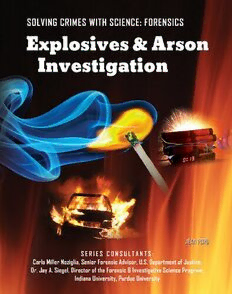
Explosives & arson investigation PDF
Preview Explosives & arson investigation
NHMC13_14HBK_Forensics_Forensics 5/3/13 9:20 AM Page 6 An uncanny calm settles on the scene. The blaze is out. A soggy, sooty mess remains. Most of us wouldn’t have a clue where to begin, yet fire and explosion investigators know precisely where and how to dig in. Other books in this series show that documents, fingerprints, stray hair, fibers, bullets, tool marks, blood spatter, SNA, cigarette butts, insects, or even a simple candy wrapper can provide clinching proof in many legal cases—but fire and bombs destroy these bits of evidence. What clues can forensic scientists possibly glean from rubble and ash? Using real-life stories as examples, Explosives & Arson Investigation explores the world of fire- and bomb-scene investigation. From first-on-the- scene priorities to collecting and documenting evidence to lab analysis and its procedures, then finally assessing motive, this book reveals basic fire characteristics, what investigators look for, how they process what they find, the meaning of specific clues, and common motives—all while high- lighting various forensic careers. BE SURE T O READ OTHER BO OKS I N TH IS SERIE S Cover images: Shutterstock.com ISBN 978-1-4222-2867-8 90000 N A E 9 781422 228678 EXPLOSIVES & ARSON INVESTIGATION Solving CrimeS With SCienCe: Forensics Computer Investigation Criminal Psychology & Personality Profiling DNA Analysis Document Analysis Entomology & Palynology Explosives & Arson Investigation Fingerprints, Bite Marks, Ear Prints Forensic Anthropology Forensics in American Culture Mark & Trace Analysis Pathology Solving Crimes With Physics EXPLOSIVES & ARSON INVESTIGATION Jean Ford Mason Crest Mason Crest 450 Parkway Drive, Suite D Broomall, PA 19008 www.masoncrest.com Copyright © 2014 by Mason Crest, an imprint of National Highlights, Inc. All rights re- served. No part of this publication may be reproduced or transmitted in any form or by any means, electronic or mechanical, including photocopying, recording, taping, or any informa- tion storage and retrieval system, without permission from the publisher. Printed and bound in the United States of America. First printing 9 8 7 6 5 4 3 2 1 Series ISBN: 978-1-4222-2861-6 ISBN: 978-1-4222-2867-8 ebook ISBN: 978-1-4222-8953-2 The Library of Congress has cataloged the hardcopy format(s) as follows: Library of Congress Cataloging-in-Publication Data Ford, Jean (Jean Otto) Explosives & arson investigation / Jean Ford. p. cm. — (Solving crimes with science, forensics) Audience: 012. Audience: Grades 7 to 8. Includes index. ISBN 978-1-4222-2867-8 (hardcover) — ISBN 978-1-4222-2861-6 (series) — ISBN 978-1-4222-8953-2 (ebook) 1. Arson investigation—Juvenile literature. 2. Fires—Juvenile literature. 3. Explosions—Juvenile lit- erature. 4. Forensic sciences—Juvenile literature. I. Title. II. Title: Explosives and arson investigation. HV8079.A7F67 2014 363.25’9642—dc23 2013006939 Produced by Vestal Creative Services. www.vestalcreative.com Contents Introduction 6 1. Igniting Interest: The Basics 9 2. Where There’s Smoke . . . : The Scene 27 3. Too Hot to Handle: The Evidence 49 4. Burning Questions: Accident or Crime? 65 5. Fire Starters: Common Motives 93 Glossary 106 Further Reading 107 For More Information 108 Index 109 Picture Credits 111 Biographies 112 Introduction By Jay A. Siegel, Ph.D. Director, Forensic and Investigative Sciences Program Indiana University, Purdue University, Indianapolis It seems like every day the news brings forth another story about crime in the United States. Although the crime rate has been slowly decreasing over the past few years (due perhaps in part to the aging of the population), crime continues to be a very serious problem. Increasingly, the stories we read that involve crimes also mention the role that forensic science plays in solving serious crimes. Sensational crimes provide real examples of the power of forensic science. In recent years there has been an explosion of books, movies, and TV shows devoted to forensic science and crime inves- tigation. The wondrously successful CSI TV shows have spawned a major increase in awareness of and interest in forensic science as a tool for solv- ing crimes. CSI even has its own syndrome: the “CSI Effect,” wherein jurors in real cases expect to hear testimony about science such as fingerprints, DNA, and blood spatter because they saw it on TV. The unprecedented rise in the public’s interest in forensic science has fueled demands by students and parents for more educational programs that teach the applications of science to crime. This started in colleges and universities but has filtered down to high schools and middle schools. Even elementary school students now learn how science is used in the crimi- nal justice system. Most educators agree that this developing interest in forensic science is a good thing. It has provided an excellent opportunity to teach students science—and they have fun learning it! Forensic science is an ideal vehicle for teaching science for several reasons. It is truly mul- tidisciplinary; practically every field of science has forensic applications. Successful forensic scientists must be good problem solvers and critical thinkers. These are critical skills that all students need to develop. In all of this rush to implement forensic science courses in secondary schools throughout North America, the development of grade-appropriate resources that help guide students and teachers is seriously lacking. This new series: Solving Crimes With Science: Forensics is important and timely. Each book in the series contains a concise, age-appropriate discussion of one or more areas of forensic science. Students are never too young to begin to learn the principles and ap- plications of science. Forensic science provides an interesting and informa- tive way to introduce scientific concepts in a way that grabs and holds the students’ attention. Solving Crimes With Science: Forensics promises to be an important resource in teaching forensic science to students twelve to eighteen years old.
